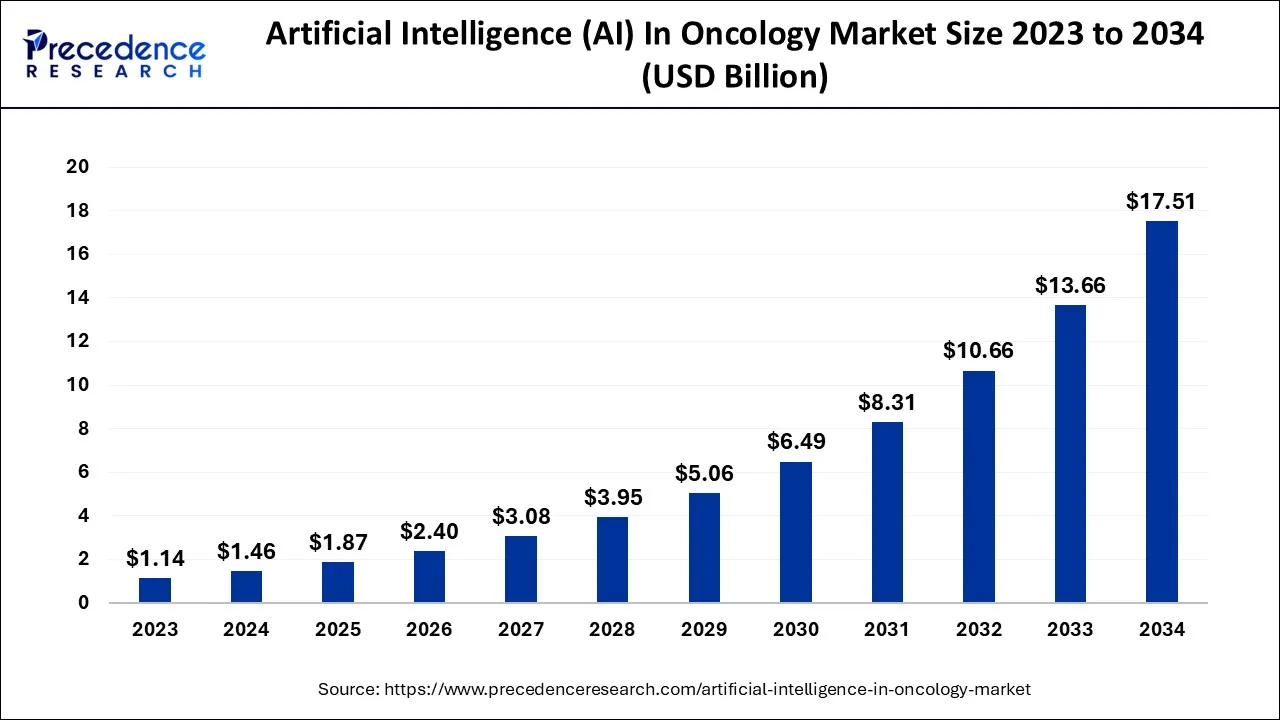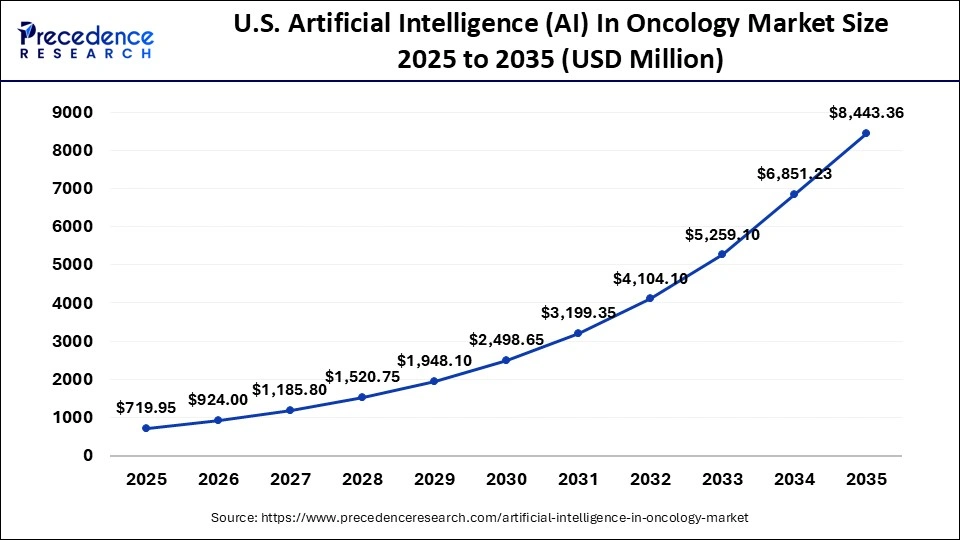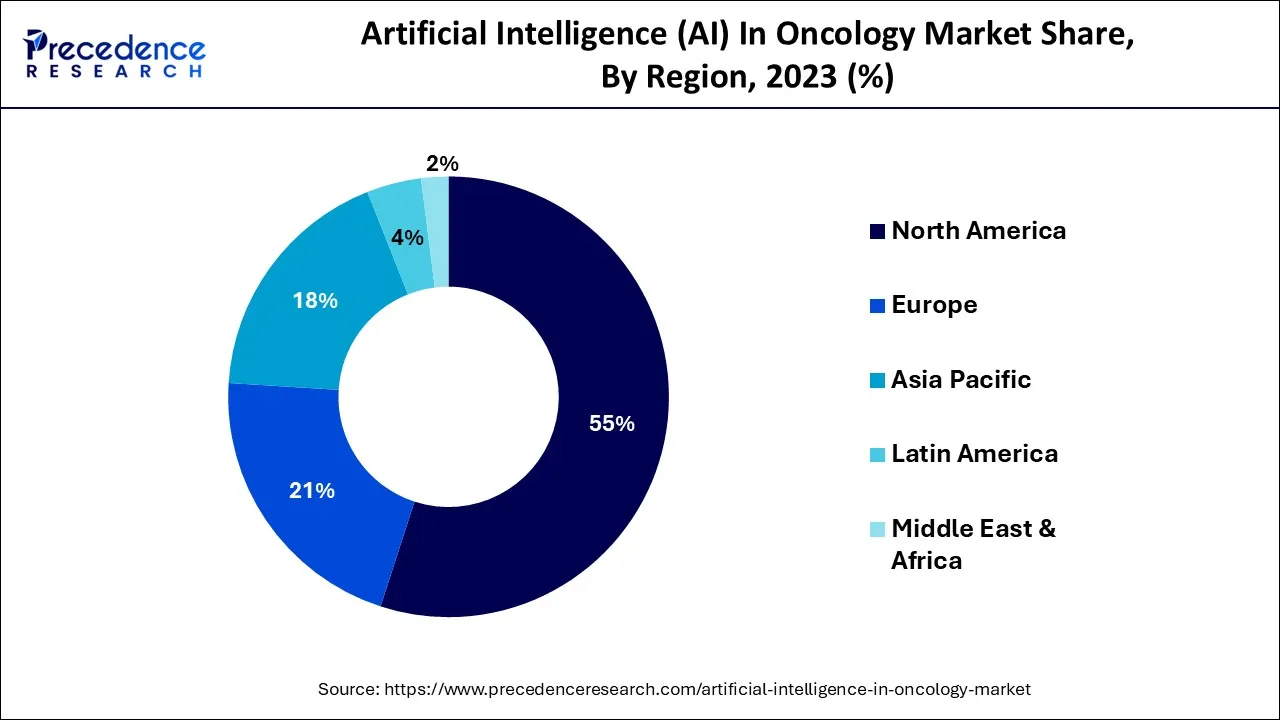Artificial Intelligence (AI) In Oncology Market Size and Forecast 2026 to 2035
The global artificial intelligence (AI) in oncology market size is valued at USD 1.87 billion in 2025 and is predicted to increase from USD 2.40 billion in 2026 to approximately USD 21.36 billion by 2035, expanding at a CAGR of 27.58% from 2026 to 2035.

Artificial Intelligence (AI) In Oncology Market Key Takeaways
- North America generated more than 55% of the revenue share in 2025.
- Asia Pacific is growing at a profitable CAGR of 30.7% from 2026 to 2035.
- The software solution component segment captured more than 44% of the revenue share in 2025.
- The service segment is predicted to grow the fastest CAGR between 2026 and 2035.
- The breast cancer type segment is predicted to grow at the highest CAGR between 2026 to 2035.
- The brain tumor segment is projected to grow at a highly profitable rate between 2026 to 2035.
- The chemotherapy treatment type segment generated around 36.2% in 2025.
- The immunotherapy treatment type segment is progressing at a CAGR of 39% from 2026 to 2035.
- The hospital end-users segment captured more than 55% revenue share in 2025.
- The diagnostic centers' users segment is projected to grow at the fastest CAGR between 2026 to 2035.
Strategic Overview of the Global Artificial Intelligence (AI) in Oncology Industry
A growing number of nations, including Finland, the United Kingdom, Germany, Israel, the United States, and China are investing in AI-based research, which is expected to play a major role in the expansion of this technology's adoption. Increased investment available in such countries is expected to accelerate market expansion even further.
For example, in 2020, investment for the 50 largest firms involved in healthcare AI research will have surpassed USD 8.5 billion. The rising percentage of tumor patients worldwide is expected to significantly contribute to market growth, and the increasing number of cases is expected to put pressure on the healthcare sector.
Furthermore, there is a severe lack of healthcare personnel, such as doctors and nurses, in hospital facilities, which is expected to boost the need for technology. The World Health Organization estimates healthcare facilities will face a 15 million medical professional shortage by 2030. With a scarcity of these experts, AI is expected to play an important part in patient treatment.
AI has a variety of applications in oncology. CanAssist Breast (CAB) assists in personalizing treatment for women diagnosed with breast cancer. CAB employs AI to predict the likelihood of cancer recurrence for each patient, on which the clinician bases treatment planning. OncoStem Diagnostics is also developing prognostic tests for other types of cancers, such as triple-negative breast cancer and ovarian cancer, by analyzing the patterns of over and under-expression of specific genes involved in tumor progression.
Market Outlook
- Market Growth Overview: The artificial intelligence (AI) in oncology market is expected to grow significantly between 2025 and 2034, driven by the precision medicine surge, rising cancer prevalence, and generative AI in drug discovery.
- Sustainability Trends: Sustainability trends involve Green AI and energy-aware computing, capacity-extending and efficiency therapies, and waste reduction through precision Oncology.
- Major Investors: Major investors in the market include NVIDIA, Google, Microsoft, Siemens Healthineers, GE HealthCare, and AstraZeneca.
- Startup Economy: The startup economy is focused on drug discovery, AI for diagnostic superiority, and cloud-native & AI as-a-service models.
Market Scope
| Report Coverage | Details |
| Market Size in 2025 | USD 1.87 Billion |
| Market Size by 2035 | USD 21.36 Billion |
| Growth Rate from 2026 to 2035 | CAGR of 27.58% |
| Largest Market | North America |
| Base Year | 2025 |
| Forecast Period | 2026 to 2035 |
| Segments Covered | By Component, By Cancer Type, By Treatment Type, and By End-Users |
| Regions Covered | North America, Europe, Asia-Pacific, Latin America and Middle East & Africa |
Market Dynamics
Drivers
Growing technological developments in the healthcare industry
The advancement of technology and the use of AI in cancer diagnostics drive the expansion of the healthcare industry. The artificial tools require low-cost diagnostic processes and quick detection data reporting.
The demand for technological advancements in the healthcare field for cancer detection and screening is also expected to boost industry growth. Furthermore, government spending on healthcare technology drives the expansion of the healthcare fields in emerging nations.
There is a growing number of cancer cases and a rising demand for early cancer detection.
The increasing awareness of the importance of early cancer detection drives the advancement of Artificial intelligence and machine learning in cancer diagnostics. The increase in the number of government programs encourages healthcare organizations and providers to integrate AI tools in their hospitals for the betterment and advancement of patient therapy.
Furthermore, the adoption of technologies enables private and nonprofit organizations to provide improved medical outcomes and lower treatment costs, thereby increasing early detection among people.
Restraints
Lack of awareness of AI applications in healthcare
The most significant hurdle to deep learning techniques is the management of massive datasets and databases, as well as the training and knowledge of AI systems as well as machine learning. However, the use of AI may result in data infringements because it may provide critical individual data like genomic sequences.
Among the various issues impeding growth are a lack of transparency, the risk of bias in AI algorithms, data used for training purposes, as well as problems encountered while AI integration authority in clinical settings.
Opportunities
Artificial intelligence is used in precision therapy and drug development for cancer
A variety of anticancer drugs are discovered, and their mechanism of action is predicted by using artificial intelligence. Various medicines and cancers are able to react differently; this information from screening processes reveals the links between therapeutic activities and the cancer genome. AI is also used to fight against resistance to anticancer drugs. Cancer treatment, imaging, screening, and medication are various domains in which AI is used. Among these, cancer imaging is the most innovative.
Challenges
The absence of structured, cancer-related health information, as well as the lack of standardization in how unstructured information is gathered and stored within an EHR or unified database of a single healthcare system, is a significant challenge in the growth of AI models.
Component Insights
In 2024, the software solution sector had the highest revenue share of around 44%. The rising number of market players who offer software to handle and interpret data and concentrate on oncology patients who require follow-up care and treatment are related to the segment's growth. The software aids in increasing efficiency, improving workflow, and saving time.
The existence of different applications, including diagnostic imaging, interventional radiology, and radiation oncology is expected to drive growth in this segment.
The service sector is also expected to grow the fastest CAGR during the projected period due to the emergence of innovative startups and entrepreneurship that provide advanced cancer treatment and prediction solutions. Concr, for example, provides a software service that employs an ML method based on a deep knowledge of scientific prediction to estimate cancer progression, which aids in accurately predicting cancer progression as a response to therapy.
Cancer Type Insights
The breast cancer sector is anticipated to grow at the highest CAGR between 2026 to 2035. Breast cancer is a common form of cancer and accounts for the majority of the market. Sedentary lifestyle adoption, environmental factors, and excessive intake of alcohol and tobacco have all contributed to an increase in cancer cases worldwide.
According to WHO statistics, approximately 2.3 million people worldwide will be screened for breast cancer in 2020. Furthermore, increasing awareness about different types of cancer and the accessibility of treatment fuels the segment's growth.
During the forecast period, the brain tumor sector is expected to grow at a hugely profitable rate. The increasing incidence of brain tumors among the world population is predicted to be an essential factor contributing to the segment's growth. As reported by the America Cancer Journal, more than 83,000 people in the United States were diagnosed with brain tumors in 2021. Furthermore, using AI in brain tumor diagnosis helps shorten diagnosis time because digital images are produced in minutes. AI models can also help with a cancer diagnosis with greater accuracy.
Treatment Insights
Chemotherapy had the largest share of the treatment segment in 2025, accounting for 36.2%. Chemotherapy is commonly used for cancer treatment procedures, with the American Cancer Society estimating that 60% of patients with Stage 4 prostate cancer receive chemotherapy. AI in chemotherapy assists clinicians in developing an individual digital profile that is utilized to customize the dose for patients during treatment.
For example, the National University of Singapore as well as the National University Cancer Institute, Singapore (NCIS), achieved positive outcomes using CURATE.AI, an AI platform that allows clinicians to create personalized and optimal doses for chemotherapy patients.
During the forecast period, the Immunotherapy sector is expected to grow at the fastest rate of 39%. The growing percentage of FDA approvals as well as extensive clinical studies demonstrating the effectiveness of immunotherapy are attributed to the segment's growth.
Furthermore, the use of AI enhances the precision of the therapy. According to a ScienceDirect article, AI can help identify major complex histocompatibility patterns linked with immunotherapy response by 91.66%. This is predicted to have a beneficial impact on segment adoption.
End-User Insights
In 2025, the hospital segment had a more than 55.0% market share. The growing adoption of AI solutions in clinics to address the scarcity of healthcare staff, as well as faster cancer diagnosis, are some of the key factors driving the market growth. For example, Addenbrooke's Hospital in Cambridge, U.K., was the first to use InnerEye, a deep learning tool developed by Microsoft Research Cambridge. The tool aids in accurately identifying tumors and reduces CT processing time and treatment planning by up to 90%.
Furthermore, diagnostic centers are anticipated to expand at the fastest CAGR between 2024 to 2034 due to government funding and rising initiatives in the healthcare field. The growth is also due to the assessment of trained staff, technologically advanced equipment, and medical professionals.
Regional Insights
U.S. Artificial Intelligence (AI) In Oncology Market Size and Growth 2026 to 2035
The U.S. artificial intelligence (AI) in oncology market size is exhibited at USD 719.95 million in 2025 and is projected to be worth around USD 8,443.36 million by 2035, growing at a CAGR of 27.91% from 2026 to 2035.

North America led the market with a more than 55.0% market share in 2025.Some of the key factors that contributed to market growth were the rising incidence of cancer as well as the availability of cutting-edge healthcare facilities. Furthermore, rising healthcare spending by regional governments is expected to drive market growth. For example, healthcare spending in the United States enhanced by 9.7% to USD 4.1 trillion in 2020. The existence of key companies in the region, such as Pfizer and Roche, is expected to expand the market in the region even further.

Asia Pacific is expected to grow at a profitable CAGR of 30.7%during the projected period because of factors such as increased initiatives undertaken by governments across the region to adopt AI services in order to enhance patient health outcomes. For example, the Australian government announced a USD 19 million package in June 2020 to support the development of AI technologies for a variety of conditions, including cancer and mental health.
Furthermore, the increased number of cancer patients in the nation is anticipated to contribute to market growth. As per data released by the Ministry of Health and Family Welfare, approximately 800,000 cases of cancer are detected in India each year.
U.S. Artificial Intelligence (AI) in Oncology Market Trends
The U.S. AI applications in medical imaging and digital pathology currently hold the largest market share. In this region, biotech firms are using generative models to design novel molecules and simulate clinical trial outcomes, reducing the time and cost of bringing new immunotherapies to market.
China Artificial Intelligence (AI) in Oncology Market Trends
China is signaling a massive pivot from generic manufacturing to innovative cancer therapies. The industry is rapidly adopting "AI-as-a-Service" subscription models across regional hubs like Shanghai and Shenzhen to ensure continuous clinical updates. Medical imaging remains the dominant sector, with NMPA-approved systems achieving in early-stage screenings for gastric and esophageal cancers.
How did Europe Experience Notable Growth in the Artificial Intelligence (AI) in Oncology Market?
Europe's Beating Cancer Plan" and the pioneering EU AI Act, which offer both strategic direction and clear legal certainty for developers. High clinical engagement and major industry events further underscore a maturing ecosystem focused on the widespread adoption of "trustworthy AI" in diagnostic and therapeutic workflows.
Germany Artificial Intelligence (AI) in Oncology Market Trend
Germany's strong ethical focus on Explainable AI (XAI) ensures trust and regulatory compliance. This ecosystem positions Germany as a leading hub for "trustworthy AI" in advanced cancer care.
Top Companies in the Artificial Intelligence (AI) in Oncology Market & Their Offerings:
- IBM: Through its Watson Health legacy and newer hybrid cloud initiatives, IBM provides the high-performance computing infrastructure necessary for large-scale genomic sequencing and oncology research.
- Azra AI: This company specializes in clinical workflow automation by using natural language processing to identify incidental cancer findings in pathology and radiology reports.
- Siemens Healthineers: Siemens integrates AI directly into its diagnostic imaging and radiotherapy hardware to provide automated organ contouring and high-precision tumor characterization.
- GE HealthCare: GE HealthCare leverages its Edison platform to host a wide array of AI apps that optimize oncology workflows, from early detection in mammography to monitoring treatment responses. They contribute by focusing on "multimodal" AI that combines imaging data with electronic health records to provide a longitudinal view of patient health.
- Intel: Intel provides the foundational hardware, such as Xeon processors and AI accelerators, that powers the intensive computational demands of deep learning in digital pathology.
- Path AI: Path AI is a leader in digital pathology, offering AI-powered image analysis that improves the accuracy of biomarker quantification, such as HER2 and PD-L1 scoring. They contribute by partnering with pharmaceutical companies to use AI-driven pathology insights to identify the right patient populations for clinical trials.
- NVIDIA: NVIDIA provides the essential GPU architecture and the MONAI framework that serve as the industry standard for training and deploying medical imaging AI.
- Concert.AI: This company provides a massive, "RWD" (Real-World Data) platform that integrates clinical and genomic data from millions of cancer patients. They contribute by offering AI-driven insights to oncology biopharma companies, helping them design more efficient clinical trials and understand real-world treatment efficacy.
- Digital Diagnostics Inc.: Known for the first FDA-cleared autonomous AI diagnostic system, this company is expanding its focus toward autonomous cancer screening at the point of care. They contribute by enabling non-specialist frontline providers to accurately identify suspicious lesions, thereby increasing early detection rates in underserved areas.
- Median Technologies: Median specializes in AI-powered imaging phenotyping through its iBiopsy platform, which focuses on the early detection and monitoring of lung and liver cancers.
Artificial Intelligence (AI) in Oncology Market Companies
- IBM
- Azra AI
- Siemens Healthineers
- GE Healthcare
- Intel
- Path AI
- NVIDIA
- Concert.AI
- Digital Diagnostics Inc.
- Median Technologies
Recent Developments
- In February 2025, DeepHealth introduced DeepHealth OS, a cloud-native operating system that replaces traditional PACS with a unified, AI-powered radiology workspace featuring automated lung, prostate, and brain health screening. DeepHealth launched the solution at the European Congress of Radiology (ECR) 2025 in Vienna. (https://deephealth.com)
- In June 2025, ASCO researchers introduced the CAPAI biomarker, an AI-driven score that predicts recurrence risk in colon cancer patients even when traditional ctDNA tests are negative. ASCO researchers unveiled this innovation at ASCO 2025 in Chicago. (https://proscia.com)
Segments Covered in the Report
By Component
- Software Solutions
- Hardware
- Services
By Cancer Type
- Breast Cancer
- Lung Cancer
- Prostate Cancer
- Colorectal Cancer
- Brain Tumor
- Others
By Treatment Type
- Chemotherapy
- Radiotherapy
- Immunotherapy
- Others
By End-Users
- Hospitals
- Diagnostic Centers
- Pharmaceutical Companies
- Research Institutes
- Others
By Geography
- North America
- Europe
- Asia-Pacific
- Latin America
- The Middle East and Africa
For inquiries regarding discounts, bulk purchases, or customization requests, please contact us at sales@precedenceresearch.com
Frequently Asked Questions
Ask For Sample
No cookie-cutter, only authentic analysis – take the 1st step to become a Precedence Research client
 sales@precedenceresearch.com
sales@precedenceresearch.com
 +1 804-441-9344
+1 804-441-9344